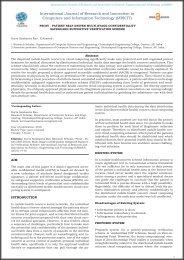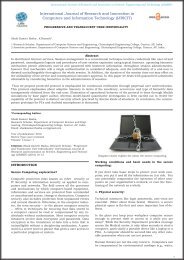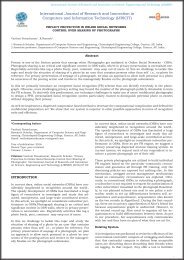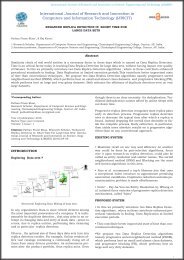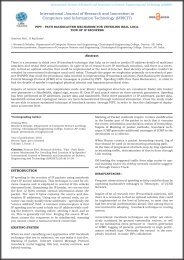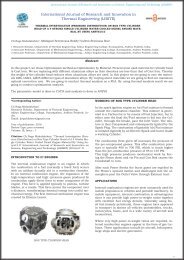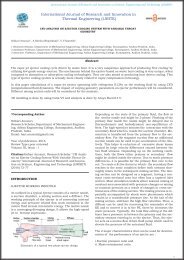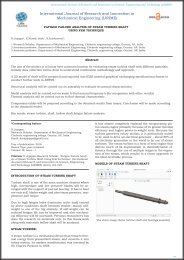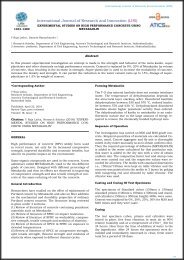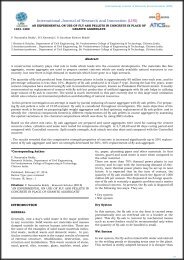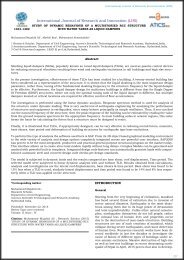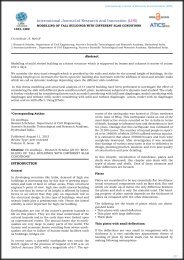STUDY ON COMPARISON OF SELF CURING OF CONCRETE BY USING NORMAL COARSE AGGREGATE AND RECYCLED COARSE AGGREGATE
Curing is the name given to the procedure used for promoting the hydration of the cement and consist a control of temperature and moisture movement from the concrete. Curing allows continuous hydration of cement and consequently continuous gain in the strength, once curing stops strength gain of the concrete also stops. Proper moisture conditions are critical because the hydration of the cement virtually ceases when the relative humidity within the capillaries drops below 80%. Proper curing of concrete structures is important to meet performance and durability requirements. In conventional curing this is achieved by external curing applied after mixing, placing and finishing. Self-curing or internal curing is a technique that can be used to provide additional moisture in concrete for more effective hydration of cement and reduced self-desiccation. When concrete is exposed to the environment evaporation of water takes place and loss of moisture will reduce the initial water cement ratio which will result in the incomplete hydration of the cement and hence lowering the quality of the concrete. An experimental study carried out an investigated the use of water-soluble polyethylene glycol (PEG 6000) as self-curing agent. In this study compressive, tensile and flexural strength of self-curing concrete for 7 and 28 days and compared the use of different coarse aggregate (i.e. M35, M45 of normal coarse aggregate and recycled aggregate) and found out optimum strength.
Curing is the name given to the procedure used for promoting the hydration of the cement and consist a control of temperature
and moisture movement from the concrete. Curing allows continuous hydration of cement and consequently
continuous gain in the strength, once curing stops strength gain of the concrete also stops. Proper moisture conditions
are critical because the hydration of the cement virtually ceases when the relative humidity within the capillaries drops
below 80%. Proper curing of concrete structures is important to meet performance and durability requirements. In conventional
curing this is achieved by external curing applied after mixing, placing and finishing. Self-curing or internal
curing is a technique that can be used to provide additional moisture in concrete for more effective hydration of cement
and reduced self-desiccation. When concrete is exposed to the environment evaporation of water takes place and loss of
moisture will reduce the initial water cement ratio which will result in the incomplete hydration of the cement and hence
lowering the quality of the concrete.
An experimental study carried out an investigated the use of water-soluble polyethylene glycol (PEG 6000) as self-curing
agent. In this study compressive, tensile and flexural strength of self-curing concrete for 7 and 28 days and compared
the use of different coarse aggregate (i.e. M35, M45 of normal coarse aggregate and recycled aggregate) and found out
optimum strength.
Create successful ePaper yourself
Turn your PDF publications into a flip-book with our unique Google optimized e-Paper software.
International Journal of Research and Innovation (IJRI)<br />
i. The compressive strength of 2% of S.C.A is more when<br />
compare to other dosages upto 28 days.<br />
ii. The strength of the conventional concrete specimen with<br />
indoor curing also showed better compressive strength<br />
when compared to 1% and 0.5% of S.C.A at 28days.<br />
iii. The specimen with 2% dosage shown better performance<br />
when compared to specimen with 0.5% and 1% of<br />
SCA and also conventional concrete at 28days.<br />
iv. The compressive strength of 2% of S.C.A of indoor curing<br />
is equal to conventional concrete of wet curing at 28<br />
days.<br />
v. The strength of the specimen in which S.C.A of different<br />
dosages other than 0.5% are shown better compressive<br />
strength when compared to conventional concrete of wet<br />
curing.<br />
vi. 2% of S.C.A has shown better strength than conventional<br />
concrete with wet and indoor curing at early age i.e.<br />
upto 7days but not as good as 1%.<br />
vii. 2% S.C.A shown better strength at 28 days & 1% has<br />
shown better performance at 7days in case of indoor curing.<br />
viii. The compressive strength is more for 1% and 2% of<br />
S.C.A and also conventional concrete in indoor curing<br />
when compared to conventional concrete in wet curing.<br />
0.5% S.C.A has shown less compressive strength when<br />
compared to other wet and indoor curing.<br />
Split tensile Strength Results for Mix A2<br />
The split tensile strength test was conducted at 7 and 28<br />
days of age for conventional concrete with wet and indoor<br />
curing and also for concrete with different dosages (0.5%,<br />
1% and 2%) of self curing agent.<br />
i. The split tensile strength of 2% of S.C.A is more when<br />
compare to other dosages upto 14 days.<br />
ii. The strength of the conventional concrete specimen<br />
with indoor curing also showed better split tensile strength<br />
when compared to 0.5% and 1% of S.C.A at 28days.<br />
iii. The specimen with 2% dosage shown better performance<br />
when compared to specimen with 0.5% and 1% of<br />
SCA and also conventional concrete at 28days.<br />
iv. The split tensile strength of 2% of S.C.A of indoor curing<br />
is equal to conventional concrete of wet curing at 14<br />
and 28 days.<br />
v. The strength of the specimen in which S.C.A of different<br />
dosages other than 2% are shown better split tensile<br />
strength when compared to conventional concrete of wet<br />
curing.<br />
vi. 1% of S.C.A has shown better strength than conventional<br />
concrete with wet and indoor curing at early age i.e.<br />
upto 7days but not as good as 2%.<br />
vii. 2% S.C.A shown better strength at 28 days & 1% has<br />
shown better performance at 7 days in case of indoor curing.<br />
viii.The split tensile strength is more for 0%, 2% and 1%<br />
of S.C.A and also conventional concrete in indoor curing<br />
when compared to conventional concrete in wet curing.<br />
ix. 0.5% S.C.A has shown less split tensile strength when<br />
compared to other wet and indoor curing.<br />
Flexural Strength Results for Mix A2<br />
The flexural strength test was conducted at 7 and 28 days<br />
of age for conventional concrete with wet and indoor curing<br />
and also for concrete with different dosages (0.5%, 1%<br />
and 2%) of self curing agent.<br />
x. The flexural strength of 2% of S.C.A is more when compare<br />
to other dosages upto 28 days.<br />
xi. The strength of the conventional concrete specimen<br />
with indoor curing also showed better flexural strength<br />
when compared to 0.5% and 1% of S.C.A at 28days.<br />
xii. The specimen with 2% dosage shown better performance<br />
when compared to specimen with 0.5% and 2% of<br />
SCA and also conventional concrete at 28days.<br />
xiii. The flexural strength of 2% of S.C.A of indoor curing<br />
is equal to conventional concrete of wet curing at 14 and<br />
28 days.<br />
xiv. The strength of the specimen in which S.C.A of different<br />
dosages other than 0.5% are shown better flexural<br />
strength when compared to conventional concrete of wet<br />
curing.<br />
xv. 1% of S.C.A has shown better strength than conventional<br />
concrete with wet and indoor curing at early age i.e.<br />
upto 7days but not as good as 2%.<br />
xvi. 2% S.C.A shown better strength at 28 days & 1%<br />
has shown better performance at 7 days in case of indoor<br />
curing.<br />
xvii. The flexural strength is more for 0%, 2% and 1%<br />
of S.C.A and also conventional concrete in indoor curing<br />
when compared to conventional concrete in wet curing.<br />
xviii. 0.5% S.C.A has shown less flexural strength when<br />
compared to other wet and indoor curing.<br />
Compressive Strength Result for Mix B1<br />
The compressive strength test was conducted at 7 and 28<br />
days of age for conventional concrete with wet and indoor<br />
curing and also for concrete with different dosages (0.5%,<br />
1% and 2%) of self curing agent.<br />
i.The compressive strength of specimen with conventional<br />
concrete is more for both wet and indoor curing when<br />
compare to other dosages.<br />
ii. The strength of the specimen in which S.C.A of different<br />
dosages (0.5% and 2%) are shown less compressive<br />
strength when compare to 1% of S.C.A.<br />
iii. The compressive strength of specimen with 1% PEG is<br />
nearly equal to 2% PEG.<br />
iv. The compressive strength of conventional concrete of<br />
wet curing is more when compare to other dosages of indoor<br />
curing.<br />
v. Conventional concrete has shown better strength in<br />
both indoor & wet curing than other specimens having<br />
SCA with different dosages.<br />
vi. Mix B with PEG is not shown better results when compare<br />
to Mix A with PEG.<br />
Split tensile Strength Result for Mix B1<br />
The Split tensile strength test was conducted at 7 and 28<br />
days of age for conventional concrete with wet and indoor<br />
curing and also for concrete with different dosages (0.5%,<br />
1% and 2%) of self curing agent.<br />
vii. The split tensile strength of specimen with conventional<br />
concrete is more for both wet and indoor curing<br />
when compare to other dosages.<br />
viii. The strength of the specimen in which S.C.A of different<br />
dosages (0.5% and 2%) are shown less tensile strength<br />
when compare to 1% of S.C.A.<br />
ix. The split tensile strength of specimen with 1% PEG is<br />
nearly equal to 2% PEG.<br />
x. The tensile strength of conventional concrete of wet<br />
curing is more when compare to other dosages of indoor<br />
curing.<br />
xi.Conventional concrete has shown better strength in<br />
both indoor & wet curing than other specimens having<br />
SCA with different dosages.<br />
247




